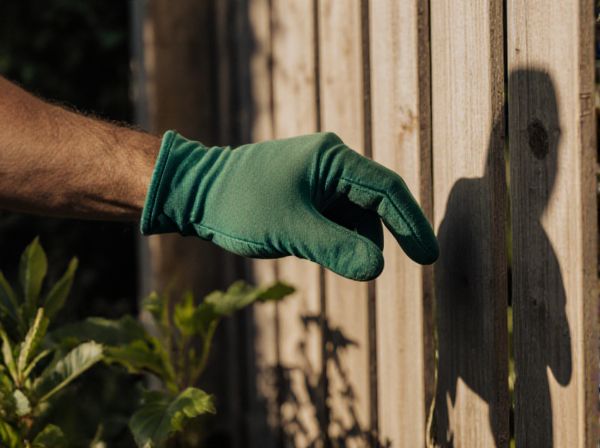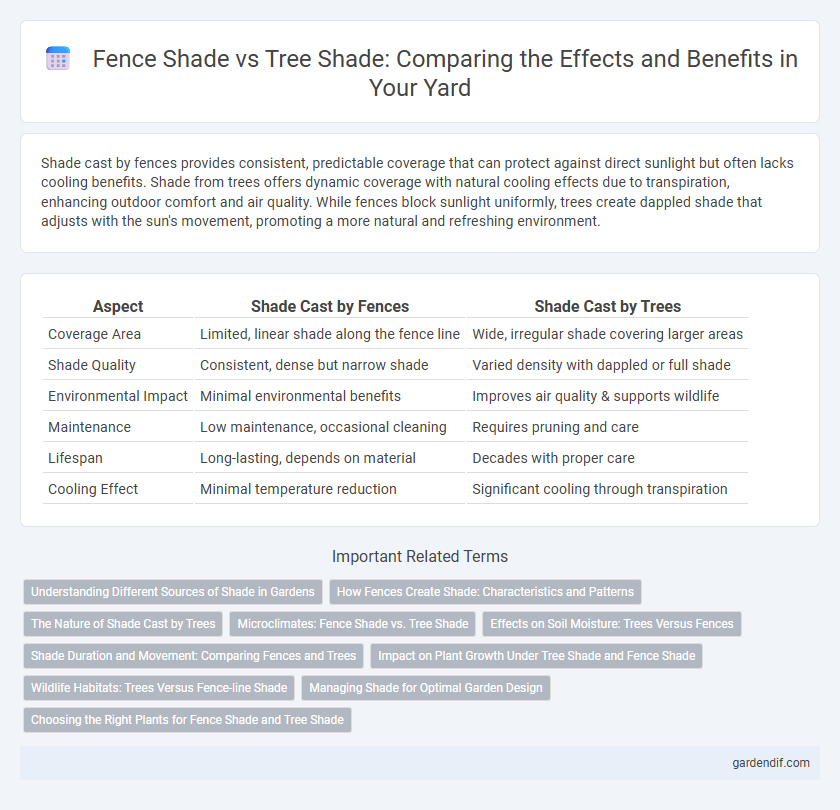
shade cast by fences vs shade cast by trees Illustration
Shade cast by fences provides consistent, predictable coverage that can protect against direct sunlight but often lacks cooling benefits. Shade from trees offers dynamic coverage with natural cooling effects due to transpiration, enhancing outdoor comfort and air quality. While fences block sunlight uniformly, trees create dappled shade that adjusts with the sun's movement, promoting a more natural and refreshing environment.
Table of Comparison
| Aspect | Shade Cast by Fences | Shade Cast by Trees |
|---|---|---|
| Coverage Area | Limited, linear shade along the fence line | Wide, irregular shade covering larger areas |
| Shade Quality | Consistent, dense but narrow shade | Varied density with dappled or full shade |
| Environmental Impact | Minimal environmental benefits | Improves air quality & supports wildlife |
| Maintenance | Low maintenance, occasional cleaning | Requires pruning and care |
| Lifespan | Long-lasting, depends on material | Decades with proper care |
| Cooling Effect | Minimal temperature reduction | Significant cooling through transpiration |
Understanding Different Sources of Shade in Gardens
Shade cast by fences provides consistent, structured coverage ideal for small garden areas, while shade from trees offers dynamic, seasonal patterns that adjust with sun angles and foliage density. Fences create predictable microclimates that protect plants from wind and excessive sun, benefiting growth in specific spots. Tree shade supports biodiversity and natural cooling but varies throughout the day, influencing plant selection and garden layout decisions.
How Fences Create Shade: Characteristics and Patterns
Fences create shade through solid or slatted structures that block or filter sunlight, producing consistent and predictable shadow patterns aligned with the fence's design and orientation. The shade cast by fences tends to be linear and uniform, offering localized cooling effects primarily on pathways or yard perimeters. Unlike trees, fence shade does not fluctuate significantly with wind or seasonal changes, providing stable shade zones.
The Nature of Shade Cast by Trees
The shade cast by trees is characterized by dynamic patterns due to the movement of leaves and branches, creating dappled light that varies throughout the day. Tree shade provides natural cooling through evapotranspiration, enhancing microclimate regulation far beyond the static, solid shadow of fences. Unlike fences, the porous canopy allows filtered sunlight that supports undergrowth and biodiversity beneath the shade.
Microclimates: Fence Shade vs. Tree Shade
Shade cast by fences creates more consistent and predictable microclimates with limited airflow and uniform temperature reduction, while tree shade produces variable microclimates due to fluctuating canopy density and natural ventilation. Tree shade enhances humidity regulation and supports diverse undergrowth by filtering sunlight through leaves, promoting ecological biodiversity. Fence shade typically results in colder, damper conditions closer to the surface, affecting soil moisture retention and plant growth differently than the dynamic shade patterns created by trees.
Effects on Soil Moisture: Trees Versus Fences
Shade cast by trees significantly reduces soil evaporation rates due to their extensive canopy cover and root systems that promote moisture retention, compared to fences which provide limited shade and do not influence soil moisture directly. Tree roots improve soil structure and increase organic matter, enhancing water infiltration and retention, whereas fences offer only physical shade without affecting soil properties. Consequently, soil beneath trees remains consistently more moist, supporting healthier plant growth and reducing irrigation needs compared to soil shaded by fences.
Shade Duration and Movement: Comparing Fences and Trees
Trees provide dynamic shade that changes in intensity and direction throughout the day due to the movement of the sun, offering longer-lasting and more adaptable coverage compared to fences. Fence shade remains static and limited in duration, primarily dependent on the fence's height and orientation relative to the sun's path. The natural canopy of trees allows for varied shade patterns and extended protection from sunlight, optimizing energy savings and outdoor comfort.
Impact on Plant Growth Under Tree Shade and Fence Shade
Tree shade creates a dynamic light environment with dappled sunlight that supports the growth of shade-tolerant plants by reducing heat stress and moisture loss. Fence shade often results in harsher, more uniform blocking of sunlight, which can limit photosynthesis and inhibit the growth of many plants due to insufficient light. Plants grown under tree shade typically exhibit better overall health and diversity compared to those under fence shade, where light limitation is more pronounced.
Wildlife Habitats: Trees Versus Fence-line Shade
Shade cast by trees creates diverse wildlife habitats by offering shelter, nesting sites, and food sources for birds, insects, and small mammals, which fences cannot provide. Fence-line shade typically lacks structural complexity and does not support the biodiversity necessary for sustaining local ecosystems. Trees contribute to ecological balance by promoting microhabitats and cooler environments vital for various species.
Managing Shade for Optimal Garden Design
Trees create broad, natural shade that varies with seasonal changes and promotes cooler microclimates, benefiting heat-sensitive plants in garden design. Fences provide consistent, localized shade ideal for controlling light exposure in specific garden areas, allowing for precise management of plant growth conditions. Balancing tree and fence shade enables optimal garden layouts, maximizing both sun and shade requirements for diverse plant species.
Choosing the Right Plants for Fence Shade and Tree Shade
Selecting plants for fence shade requires species tolerant of lower light levels, such as hostas, ferns, and ivies, which thrive in the limited sun penetration typical of fence shade. In contrast, tree shade benefits from plants adapted to dappled or intermittent light, including astilbes, hydrangeas, and shade-tolerant ground covers that can handle variable sunlight under a tree canopy. Matching plant species to the specific light conditions created by fences or trees optimizes growth and aesthetic appeal in shaded garden areas.
shade cast by fences vs shade cast by trees Infographic

 gardendif.com
gardendif.com